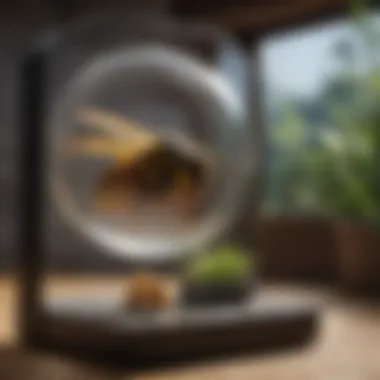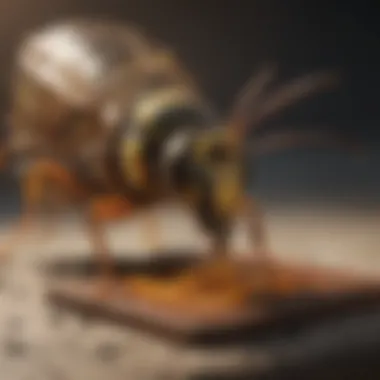The Best Indoor Wasp Traps for Effective Management


Intro
Wasp intrusions can cause significant distress for homeowners. Understanding these pests is crucial in devising effective control strategies. This article explores various indoor wasp traps, their functionality, and aspects that homeowners should consider for effective pest management. The focus is on revealing practical, informed decisions for pest control enthusiasts and everyday homeowners.
Understanding Pests
Definition of Pests
Pests are organisms that are considered detrimental to humans, agriculture, or the environment. Within this category, wasps, specifically the common yellowjacket and paper wasp, often invade homes looking for food and shelter. Their presence can pose risks, including painful stings and potential allergic reactions.
Importance of Pest Identification
Proper identification of wasps is essential. Understanding their species can affect trap choice and placement. For instance, yellowjackets tend to build their nests in walls or shallow underground, while paper wasps prefer eaves and overhangs. Recognizing these behaviors leads to more effective trap deployment and enhances the overall success of pest control efforts.
Prevention Techniques
Home and Garden Preventative Measures
Preventing wasps from entering your home begins with eliminating attractants. Keep trash cans sealed tightly and avoid leaving food out. Maintaining clean outdoor areas is also vital. Regularly check gardens for ripe fruit or sweet substances that could attract wasps. Another effective measure is to seal potential entry points, such as gaps in windows and doors.
Seasonal Prevention Tips
Wasps tend to be more active during late summer and early fall. During this time, homeowners should be more vigilant. For instance, inspecting properties more frequently for nests can prevent infestations before they surface. Additionally, using repellent plants like mint or eucalyptus around the house can deter wasps from establishing nests nearby.
Eco-Friendly Pest Control Solutions
Overview of Sustainable Practices
Insect traps can be environmentally friendly. Many traps use non-toxic materials and methods to capture wasps without harming the environment. Choosing traps made from sustainable materials reduces chemical use, maintaining ecological balance while managing wasp populations.
Natural Remedies and Their Effectiveness
For those looking for alternatives to chemical solutions, natural remedies may offer relief. Simple mixtures, such as vinegar and sugar with a touch of water, can be effective. This combination attracts wasps, trapping them in a container. Although these methods may not ensure complete elimination, they provide a non-toxic approach for minimizing wasp presence.
"Effective wasp management combines understanding, prevention, and ecological consideration."
Overall, utilizing indoor wasp traps along with preventive measures forms a comprehensive strategy for managing wasp intrusions. Homeowners can achieve a wasp-free environment, ensuring safety and peace of mind.
Preamble to Indoor Wasp Control
Wasp infestations can lead to discomfort and even dangerous situations for homeowners. Understanding effective ways to control these pests is critical. Indoor wasp management is essential not only for personal safety but also for maintaining a peaceful living environment. Throughout this guide, various aspects of wasp traps will be explored, helping readers make informed decisions.
Understanding Wasps
Wasps are part of a broader family of insects that include bees and ants. They play important roles in ecosystems, such as pollination and pest control. Nevertheless, when they invade human habitats, they can become a nuisance. Most indoor wasps are drawn to food and sugary substances.
They are typically recognized by their slender bodies and distinct yellow or black markings. Understanding their behavior is crucial in order to implement effective traps. Knowing where they are likely to nest or gather helps in selecting the right type of trap. Homeowners should familiarize themselves with the common wasp species, such as the paper wasp and yellow jacket. Each species may require different approaches for effective capture. Identifying wasps can significantly influence the choice of trapping methods.
The Importance of Indoor Wasp Management


Effective indoor wasp control prevents potential stings, which can cause allergic reactions in susceptible individuals. The presence of wasps can also disrupt daily life, deterring people from enjoying their homes fully. While some wasp species might not be aggressive, they can still become a problem if they feel threatened. Therefore, proactive wasp management is not just about removal but also prevention.
Homeowners should consider that indoor wasps can signal larger infestations outside their homes. Immediate management can prevent these problems from escalating. Furthermore, the implementation of environmentally friendly traps can lessen the ecological impact, which is appealing to many homeowners today. This guide will cover various methods and considerations step by step, ensuring a thorough understanding of effective indoor wasp control.
Types of Indoor Wasp Traps
Understanding the types of indoor wasp traps available is crucial for effective pest management. Each type offers specific functionalities that cater to various needs and preferences. Homeowners must consider the purpose of these traps, ease of use, and the environment where they will be placed. This section will discuss three primary types: sticky traps, baited traps, and electric traps, highlighting their features and benefits.
Sticky Traps
How They Work
Sticky traps operate on a straightforward principle. These traps utilize adhesive surfaces to capture wasps that come into contact with them. The unique feature of sticky traps is that they do not require any bait or attractant. This simplicity makes them a popular choice for indoor environments. One advantage is that they can be placed unobtrusively in various locations, allowing for discreet wasp management. However, since they rely on wasps landing on them, their effectiveness is somewhat limited compared to other trap types.
Best Practices
Using sticky traps effectively can significantly enhance their performance. Best practices include placing them in areas where wasps are frequently seen. Key characteristics of optimal placement involve securing them away from direct sunlight and avoiding any immediate wind exposure. Such arrangements help maintain the adhesive quality. A unique aspect of these best practices is the regular monitoring and replacement of traps. Timely replacement can ensure that they remain effective, as a full trap will not capture new insects.
Baited Traps
Chemical vs Chemical-Free Baits
Baited traps use attractants to lure wasps. There are two main categories: chemical and chemical-free baits. Chemical baits often contain odors that appeal to the target wasps, effectively drawing them in. They can be beneficial as they increase the capture rate significantly. However, there are concerns regarding environmental and health impacts associated with these chemicals. In contrast, chemical-free baits focus on natural ingredients that can be just as effective without the downsides.
Trap Efficacy
The efficacy of baited traps is generally higher than sticky traps. When properly set up, they can capture a substantial number of wasps. A critical consideration is the attractant used; the right bait can make a significant difference in performance. However, baited traps necessitate careful monitoring. If the bait becomes less attractive over time, the trap will lose its effectiveness. Hence, regular checking and re-baiting are essential tasks for users.
Electric Traps
Functionality
Electric traps utilize an electrified grid to kill wasps that enter the trap. The functionality of these traps hinges on their mechanism, which allows them to capture pests more rapidly than passive traps like sticky and baited options. Users might find this approach appealing due to its efficiency in dealing with larger wasp populations. However, it’s crucial to consider the power source for electric traps, as reliance on electricity might limit their placement in specific locations.
Safety Considerations
When using electric traps, safety becomes a paramount consideration. The key characteristic is the need to ensure that the trap is placed securely, preventing accidental contact with humans or pets. This feature addresses concerns about using electrocution as a control method. However, users must remember the potential hazards and follow guidelines strictly to avoid accidents. Appropriate usage can mitigate risks and encourage safe indoor environments.
Always be mindful of the risks while utilizing electric traps to ensure a safe atmosphere in your home.
In summary, understanding the types of indoor wasp traps provides a foundation for effective wasp management. Each trap type has distinctive features that cater to various preferences and needs, and their effectiveness can vary based on environmental conditions and proper usage.
Factors to Consider When Choosing a Trap
When deciding on an indoor wasp trap, several crucial factors must influence your choice. Each element contributes to the catch rate and effectiveness against wasps, ensuring swift resolution to any pest problems. Understanding these factors helps homeowners make informed decisions that align with their specific needs, preferences, and circumstances.
Location of Use
The placement of the trap significantly impacts its efficiency. If you have a high wasp activity area, such as near windows or sources of food, positioning the trap in a visible place is essential. Traps should ideally be placed at the entrance points where wasps are likely to enter your home, such as doors or nearby open windows. Ensure it does not interfere with daily activities or create hazards for children and pets. In confined spaces, consider traps that blend with the environment or are less obtrusive.
Target Wasp Species


Knowing which wasp species are invading your space can refine your approach to trapping. Different species respond to various bait types, and understanding these nuances is vital. For example, yellowjackets are often attracted to sweet baits, while paper wasps may require protein-based options. Identifying species not only improves trap selection but also enhances overall trapping success and minimizes unnecessary pest captures. Research the common wasps in your area.
Environmental Impact
As awareness around environmental issues grows, the ecological implications of pest control measures cannot be overlooked. Selecting traps with eco-friendly components and those that uphold safety for non-target species is essential. Products utilizing natural baits or non-toxic lures are preferable to preserve beneficial insects and maintain a balanced environment. Evaluate the materials used in trap construction as well. Favor traps with recyclable or biodegradable parts to reduce your carbon footprint.
Choosing the right trap goes beyond simply catching wasps; it encompasses safety, effectiveness, and environmental responsibility.
In summary, evaluating location, target species, and environmental impact are critical when choosing an indoor wasp trap. They shape the effectiveness and ensure safety for your household and the environment. Taking the time to consider these factors makes a significant difference in pest control efforts, leading to better results.
Top Indoor Wasp Traps Reviewed
In the realm of wasp control, reviewing top indoor traps is critical for effective management. Each product offers unique features and functionalities tailored to different spaces and needs. Understanding these can empower homeowners and pest control enthusiasts in making informed decisions. The effectiveness of the traps influences the overall approach to managing wasp issues indoors.
Product A
Overview
Product A stands out due to its innovative design. It is a baited trap that draws wasps in with an attractive lure. This feature is beneficial because it allows for broader coverage in larger rooms. The design promotes discreet use in various settings, making it a popular choice among homeowners. Its sleek appearance blends well with home decor.
Features
Key features of Product A include easy setup and maintenance. It comes with a refillable bait station. This feature is popular since it reduces waste and allows users to adjust bait as needed. The trap also has a sturdy construction that ensures durability over time. However, some users found cleaning the unit difficult due to its intricate parts.
Pros and Cons
The advantages of Product A are substantial. First, its effectiveness in capturing wasps is commendable. Second, it manages to do this without emitting strong chemicals, appealing to eco-conscious users. On the downside, it may not be as effective in high wasp population areas, and some users report that it requires frequent refilling during peak activity times.
Product B
Overview
Product B features an electric trap that utilizes an attractant light. This function is designed to lure wasps effectively, particularly in darker locations. This makes it a distinctive choice compared to traditional traps. The electrical component allows for immediate dispatching of the insect, which is an efficient method of control. Many users find it particularly reliable during dusk when wasps are most active.
Features
Notably, Product B includes a built-in safety mechanism that prevents accidental activation. This feature ensures it can be safely used around pets and children. Furthermore, it operates quietly, making it suitable for indoor environments. However, it does require access to an electrical outlet, which can limit placement options.
Pros and Cons
Product B excels in its swift action against wasps. The silent operation during the evening hours means it does not disrupt household activities. However, the reliance on electricity can be a drawback in power outage situations. Another downside noted by users is the initial cost, which may be higher compared to other traps.
Product
Overview
Product C constitutes an environmentally friendly sticky trap. This trap employs natural pheromones to attract wasps. Its construction utilizes biodegradable materials, appealing to eco-conscious users. The simplicity of the product is appealing for those looking for an easy solution that integrates smoothly into their homes.
Features
The standout feature of Product C is its high adhesive strength, ensuring captured wasps remain secured. Moreover, it can be hung conveniently near windows or doors, which is often where wasps enter a home. While effective, it does require careful placement to avoid capturing beneficial insects.


Pros and Cons
With its user-friendly design and eco-friendly materials, Product C is an excellent choice for environmentally conscious households. The effective adhesive means it performs well if placed correctly. However, it lacks the immediate extermination features found in other traps, as it relies on trapping rather than killing. Additionally, improper placement can lead to unintended captures.
Practical Tips for Using Indoor Wasp Traps
Using indoor wasp traps effectively requires knowledge and strategy. Knowing how to use these traps correctly can significantly increase their effectiveness. This section provides practical tips to maximize the potential of indoor wasp traps, enabling homeowners to manage wasp intrusions with more confidence and success.
Optimal Placement Strategies
Placing traps properly is crucial for attracting and capturing wasps. Here are some considerations:
- Identify High Traffic Areas: Observe where you frequently see wasps. Common locations include near windows, doors, and areas with food sources.
- Avoid Direct Sunlight: Many traps work better in shaded areas. Wasps may avoid traps that are too hot.
- Height Matters: Hang or place traps at eye level or slightly higher. This position increases visibility and accessibility.
- Distance from Entry Points: Ensure traps are not too close to doors or windows. This distance helps reduce the chances of wasps entering your home.
- Rotating Locations: Occasionally changing trap locations can renew interest and improve captures over time.
By using these optimal placement strategies, homeowners can improve the likelihood of trapping more wasps.
Maintenance and Replacement
To ensure traps remain effective, maintenance and timely replacement are important. This involves:
- Regular Inspection: Check traps often to see if they are full or dirty. If the trap is full, wasps may not be attracted to it.
- Cleaning Traps: If a trap is reusable, clean it according to manufacturer instructions. This prevents mold and odors that might deter wasps.
- Replacement Schedule: Even the best traps have a life span. Replace traps after a certain number of captures or at the start of each season.
- Seasonal Adjustments: As wasp activity varies seasonally, adjust your strategy accordingly. For example, more traps may be needed during peak summer months.
By implementing these maintenance tips, homeowners can keep traps working properly, ensuring ongoing wasp control success.
"Effective wasp management lies in understanding trap placement and maintenance. By following these guidelines, one can greatly enhance the functionality of indoor wasp traps."
Alternative Approaches to Wasp Control
Considering wasp management, it is essential to explore alternatives beyond traditional traps. These methods can complement the use of indoor wasp traps, creating a comprehensive strategy for effective control. Some homeowners may prefer these methods due to concerns about the environmental impact or the presence of chemicals in bait traps. Here, we will discuss two significant approaches: natural repellents and professional pest control services.
Natural Repellents
Natural repellents offer a chemical-free option for deterring wasps. They utilize common household items that can effectively make areas less attractive to these pests.
- Vinegar and Soap Mixture: A popular mixture involves combining vinegar, which wasps detest, with a few drops of dish soap. The soap breaks the surface tension of the vinegar, causing wasps that land on it to sink and drown. This method is eco-friendly and can be utilized around living spaces.
- Essential Oils: Certain essential oils, such as peppermint or citronella, are known to repel wasps. Spraying these diluted oils around entrances and nests could decrease wasp activity in those areas. However, effectiveness varies, and some trial and error may be needed to find the right solution.
Using natural repellents can prevent the need for more aggressive trapping methods. They create a hostile environment for wasps without harming beneficial insects.
Professional Pest Control Services
In cases of severe wasp intrusions, relying on professional pest control services may be the most efficient approach. These experts possess the training and tools necessary to tackle nests safely and effectively.
- Assessment: Professionals begin by assessing the infestation extent—identifying specific wasp species and their nesting locations. Understanding the behavior of different species helps tailor the control strategy.
- Targeted Solutions: After evaluation, pest control technicians employ various methods, ranging from chemical treatments to humane removals, depending on the situation. They have access to professional-grade products that might not be available to the average homeowner, ensuring a more thorough approach.
- Safety Considerations: Hiring professionals also minimizes the risk for homeowners. Dealing with aggressive wasps can lead to painful stings and allergic reactions. This alternative is beneficial for individuals who may be allergic or are uncomfortable handling pests personally.
Culmination
The topic of effective indoor wasp management is paramount for creating a safe and comfortable living environment. This article delves into critical aspects of controlling wasp intrusions. Understanding the various types of wasp traps available allows homeowners to make informed choices. These traps not only help manage the immediate problem but also mitigate potential risks associated with wasps, such as allergic reactions. By investing in the right trap and implementing practical usage strategies, individuals can significantly reduce the likelihood of wasp encounters.
Summarizing Key Takeaways
To sum up, several key takeaways emerge from this article:
- Types of Traps: There are different types of traps, including sticky traps, baited traps, and electric traps. Each type has its own unique features and best use cases.
- Selection Criteria: When choosing a trap, consider location, target wasp species, and environmental impact. These factors determine how effective the traps will be in your specific situation.
- Practical Tips: Effective placement and regular maintenance of traps enhance their efficacy. This ensures that they function as intended and help reduce wasp populations indoor.
Future Trends in Wasp Management
Looking ahead, several trends are likely to shape the future of wasp management. Innovations in trap design will focus on eco-friendliness and increased efficacy. Increased awareness among homeowners about natural repellents will also likely grow, encouraging more chemical-free pest control methods. Furthermore, advancements in technology may provide new solutions, such as smart traps that notify users when they have caught wasps. Tying these emerging trends to broader environmental considerations will be crucial for future pest management strategies.



